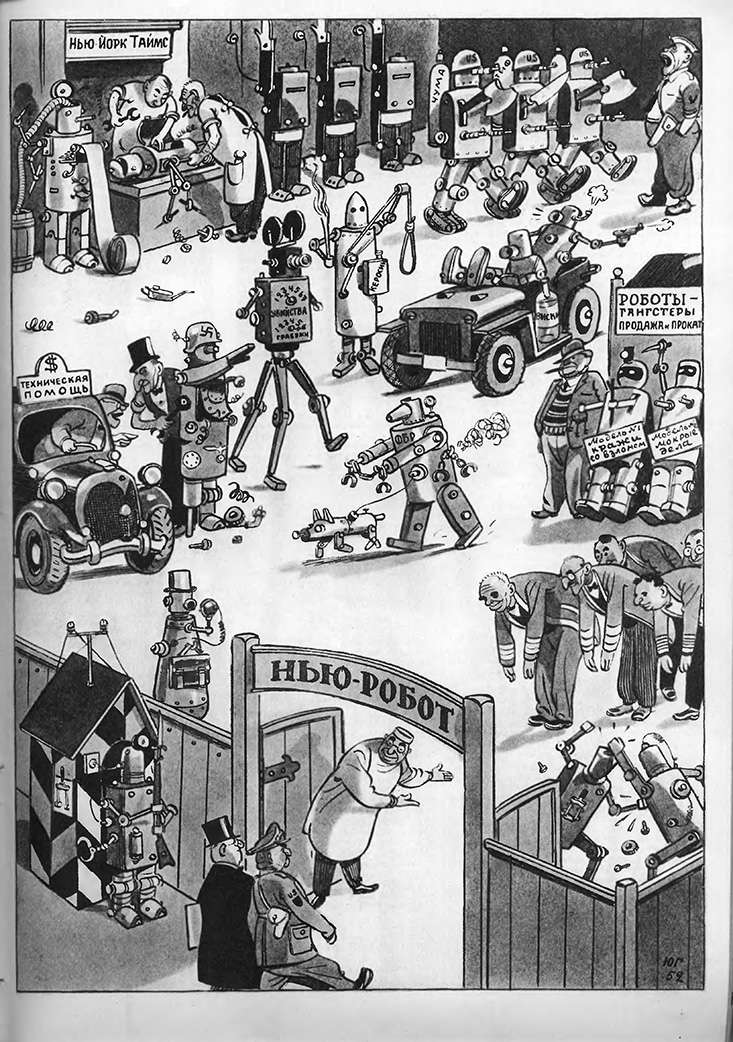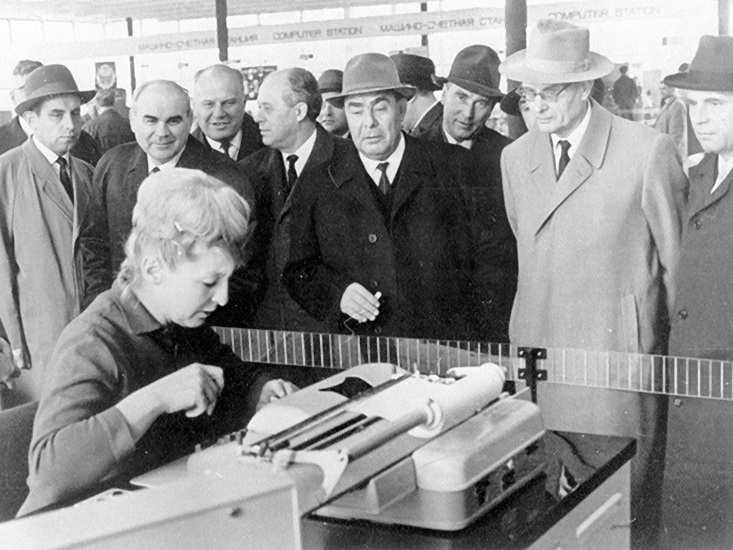In 1950, with the Cold War in full swing, Soviet journalists were looking desperately for something to help them fill their anti-American propaganda quota. In January of that year, a Time Magazine cover appeared that seemed to provide just the thing. It showed an early electromechanical computer called the Harvard Mark III, and boasted the cover line, “Can Man Build a Superman?”
Here was a target that checked the ideological boxes. In May of 1950 Boris Agapov, the science editor of the Soviet Literary Gazette, penned a scornful critique of the American public’s fascination with “thinking machines.” He scoffed at the capitalist’s “sweet dream” of replacing class-conscious workers and human soldiers—who could choose not to fight for the bourgeoisie—with obedient robots. He mocked the idea of using computers for processing economic information and lampooned American businessmen who “love information [like] American patients love patented pills.” He poured contempt on the Western prophets of the information age, especially the most prominent of them—cybernetics creator Norbert Wiener, a mathematics professor at the Massachusetts Institute of Technology. Cybernetics, which was then just a couple of years old, declared that control and communication mechanisms in biology, technology, and society were fundamentally the same. Of course, Agapov did not actually read Wiener’s famous book on the topic, called Cybernetics; the content of his article makes clear that all he knew about cybernetics was borrowed from the January 23 issue of Time, and possibly largely from its cover image.
In the paranoia-filled environment of the Soviet media, Agapov’s article was perceived as a signal from above. The psychologist Mikhail Iaroshevskii took the hint and published two scathing attacks on cybernetics, one in the Literary Gazette and another in a 1951 collection of papers titled Against the Philosophizing Henchmen of American and English Imperialism. He accused Wiener of reducing human thought to formal operations with signs, and labeled cybernetics a “modish pseudo-theory” fabricated by “philosophizing ignoramuses” and “utterly hostile to the people and to science.” He went on to cite Wiener’s well-known remark that the computer revolution was “bound to devalue the human brain” in the same way that the industrial revolution had devalued the human arm. While Wiener meant his comment to be a liberal critique of capitalism, and called on having “a society based on human values other than buying and selling,” Iaroshevskii apparently interpreted it as a misanthropic escapade. “From this fantastic idea,” he wrote, “semanticists-cannibals derive the conclusion that a larger part of humanity must be exterminated.” Like Agapov, Iaroshevskii hadn’t bothered to read any of Wiener’s writing. Actually, it wouldn’t have been easy: Wiener’s Cybernetics was withdrawn from Soviet libraries after Agapov’s attack. Instead, Iaroshevskii drew his arguments for his critique largely from Agapov’s earlier article.
The Soviet Union began to secretly pursue military computing while condemning the West for doing the same.
As one critic echoed another, repeating older accusations and making up new ones, an anti-cybernetics campaign coalesced. Critics didn’t let their ignorance of the actual content of cybernetics stop them—in fact, it helped to unleash their imagination. Skillfully manipulating a handful of quotations of Wiener taken out of context, they stretched the clothing of cybernetics over an ideological straw man. Wiener’s passing remark that “information is information, not matter or energy” was exaggerated to become the claim that information had “nothing to do with matter or consciousness,” and the critics concluded that cybernetics was marching along a “straight road toward open idealism and religion” (both were, of course, pejorative terms in the Soviet Union).
Philosophers chimed in, bashing cybernetics for “clinging to the decrepit remnants of idealistic philosophy,” as well as for being “mechanistic” in reducing the activity of the human brain to “mechanical connection and signaling.” Cybernetics, they claimed, was doubly guilty. It deviated from dialectical materialism, the official Soviet philosophy of science, in two opposite directions—toward idealism and toward mechanicism—at the same time. The media portrayed it as both “idealistic” and “mechanistic,” “utopian” and “dystopian,” “technocratic” and “pessimistic,” a “pseudo-science” and a dangerous weapon of Western military aggression. Soviet critics ignored, or possibly were unaware of, Wiener’s openly pacifist stand, which he had taken after Hiroshima, and his refusal to participate in military research.

The trouble with these public attacks against the use of computers was, of course, that the country desperately needed computers. The military, in particular, recognized the value of the nascent technology, and the risks of being left behind.
So, in a classic example of “doublespeak,” the Soviet Union began to secretly pursue military computing while condemning the West for doing the same. While the press ridiculed American “fantasies” of robots giving military orders, Sergei Sobolev, the chief mathematician of the Soviet nuclear weapons program, tirelessly promoted the development of new computers. These included the Soviet Union’s first computer, the MESM, and its first small computer, the M-1.
The Soviets even launched a capitalist-style competition between two competing programs in January 1950, the same month that Time Magazine ran its famous cover. Each top-secret program was tasked with building large, high-speed electronic computers for military calculations. One, called the BESM, was developed by the Soviet Academy of Sciences; the other, Strela, by the Ministry of Machine-Building and Instrument Construction. Both agencies poured enormous resources into these flagship projects and in 1954, Strela was declared the winner. Seven copies of the gigantic, room-sized machine were produced and put to military service, helping with the design of the hydrogen bomb, nuclear strike efficiency simulations, missile defense system design, and various navy and air force projects. An improved version of the BESM became the fastest computer in Europe, and soon went into production as well. Computer specialists paid lip service to the anti-cybernetics campaign during their political education sessions, and then went to work developing new military control and communication systems based on cybernetic principles.
Working with computers required special care: One had to avoid using any suspicious cybernetic terms. Even the phrase “logical operations” was risky, because it might be interpreted as implying that machines could think. Instead of “computer memory,” researchers used the more neutral, technical term, “storage.” “Information” was replaced by “data,” and “information theory” by the convoluted expression “the statistical theory of electrical signal transmission with noise.” A joke about Stalin’s henchman, Beria, who was responsible for the nuclear weapons program, became popular. Beria comes to his boss and asks permission to use the notorious field of cybernetics for military purposes. Stalin puffs on his pipe and says, “Okay, but just please make sure the other Politburo members don’t find out.”

By 1953, Soviet cybernetics had spent three years in the doghouse. Its fortunes finally began to turn when, in March of that year, Stalin died, and when the Soviet Union tested its first thermonuclear device five months later (the United States had tested theirs two years before). Scientists and engineers, emboldened by the reputation they had earned for their military work, began to push back against ideologues and Party hacks, who had been supported by Stalin. Disciplines that had been suppressed under Stalin, such as genetics and mathematical economics, began to come back to universities and research labs. Scientists and computer specialists began arguing for a similar rehabilitation of cybernetics. In August 1955, the journal Problems of Philosophy, which had published scathing critiques of cybernetics, suddenly reversed its position, like a weathervane sensing the winds of change. It published a landmark article in support of the discipline, called The Main Features of Cybernetics.
The article was signed by three heavyweights from the world of military computing, and dismissed all ideological accusations against cybernetics. Instead of trying to reconcile it with dialectical materialism, the authors simply stated that it works, and therefore it must be ideologically correct. Having read Wiener’s work in the classified sections of military research libraries, they synthesized a Soviet version of cybernetics that drew its legitimacy from the practical value of computer technology.
The article spurred cybernetics enthusiasts to promote the introduction of computers into various sectors of the civilian economy—from transportation and industrial automation, to weather forecasting and economic planning. Once again, the ideological clichés of the regime were brought to bear, but this time in support of the burgeoning field. Researchers began publishing an annual series called Cybernetics in the Service of Communism, stressing the bright prospect of computers helping to build a new society.
Big Brother, who wanted to see everything and know everything, became overwhelmed with information.
Party leaders were soon convinced, and the 1961 Communist Party Program singled out cybernetics as crucial to the construction of communism. The government issued a string of resolutions authorizing the construction of new computer factories, and the popular press began touting computers as the “machines of communism.” The word “cybernetics” abandoned its spot on the blacklist and became a trendy moniker. Genetics was now “biological cybernetics,” non-Pavlovian physiology “physiological cybernetics,” and mathematical economics “economic cybernetics.” Cybernetics was adopted as a new language for the organization of biological systems, and in physiology, it helped replace the simplistic Pavlovian scheme of conditional reflexes, based on a telephone switchboard metaphor, with more sophisticated models that compared the brain to an information processor. Even the law turned its attention to “judicial cybernetics”; legal scholars dreamt of making their concepts “as exact as [those] of mathematics, physics, and chemistry.” The Soviet computer had been rebooted.
The cybernetics agenda in economics and management was especially daring. In a remarkable pre-Internet vision, researchers proposed to link together all Soviet enterprises through a unified national computer network which would process economic information in real time and optimize the entire economy. The proposal caused serious alarm among CIA analysts, who began to suspect that cybernetics was becoming too powerful a tool in the hands of the Soviet government. They raised concern with the Kennedy administration, and in October 1962 Arthur Schlesinger, Jr., President Kennedy’s special assistant, wrote a memo in which he gloomily predicted that the “all-out Soviet commitment to cybernetics” would give the Soviets “a tremendous advantage.” Schlesinger warned that, “by 1970 the USSR may have a radically new production technology, involving total enterprises or complexes of industries, managed by closed-loop, feedback control employing self-teaching computers.” A special expert panel was set up to investigate the Soviet cybernetic threat.
What Schlesinger may not have appreciated is the degree to which the Soviet establishment was appropriating cybernetics for the purpose of maintaining their administrative hierarchies, and resisting reform. When the Soviet government launched a mammoth effort to introduce computerized management systems into the economy for production control and planning in the 1970s, it did so without fundamentally changing management structures or the balance of power.

This proved to be a grave mistake. The centrally planned Soviet economy was poorly prepared for computerization. Its cumbersome bureaucracy was too slow to implement rapid changes in production and distribution, and it was ruled by industrial ministries which, like separate fiefdoms, did not want to share their information or decision-making power. Each ministry therefore created its own information management system, disconnected from and incompatible with the others. Instead of transforming the top-down economy into a self-regulating system, bureaucrats used their new cybernetic models and computers to protect their power. Expensive and largely useless information management systems were strewn across the country.
The results of top-down computerization were devastating. New computer systems accumulated ever-increasing amounts of raw data and generated terrifying heaps of paperwork. In the early 1970s, roughly 4 billion documents per year circulated through the Soviet economy. By the mid-1980s, after Herculean efforts to computerize the bureaucratic apparatus, this figure rose by a factor of 200 to about 800 billion documents, or 3,000 documents for every Soviet citizen. All this information still had to pass through narrow channels of centralized, hierarchical distribution, squeezed by institutional barriers and secrecy restrictions. Management became totally unwieldy. To get an approval for the production of an ordinary flat iron, for example, a factory manager had to collect more than 60 signatures. Technological innovation became a bureaucratic nightmare.
Big Brother, who wanted to see everything and know everything, became overwhelmed with information that was often distorted by lower-level officials trying to present a rosy picture. Vast clogs of inaccurate information paralyzed the decision-making mechanism, while accurate information was exchanged only locally, like black-market goods or forbidden books in the samizdat. Computers, once vilified and now championed, were constant in one thing: They amplified the virtues and deficits of the system that implemented them. After all, the key idea behind cybernetics was control via feedback. In the hands of self-motivated free agents, it was a powerful economic engine. In the hands of a single controlling agency, it brought stagnation. Or, as computer scientists like to say, “garbage in, garbage out.” Called in to prove the superiority of socialism, information technology eventually proved the ineffectiveness of the Soviet regime.
The irony of the situation was not lost on Soviet humor. As one joke tells it, Brezhnev is gifted with the latest in artificial intelligence, so he asks it “When will we have built communism?” The computer responds, “In 17 miles.” Brezhnev thinks, “There must be something wrong,” and repeats the question. The computer again replies, “In 17 miles.” Angered by the incomprehensible reply, Brezhnev orders a technician to investigate the machine. “Everything is correct,” replies the technician after some time. “You said it yourself: Every five-year plan is one step toward communism.”
Slava Gerovitch is a lecturer on the history of mathematics and director of research programs in the Mathematics Department at MIT. An expert on the history of Russian science and technology, he is the author of From Newspeak to Cyberspeak: A History of Soviet Cybernetics, and two books about Soviet space exploration.





























